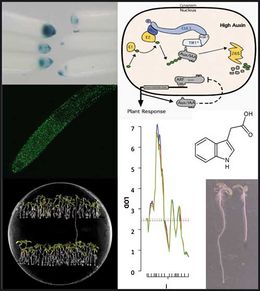Quint Lab: Difference between revisions
Marcel Quint (talk | contribs) No edit summary |
Marcel Quint (talk | contribs) No edit summary |
||
| Line 9: | Line 9: | ||
[http://en.wikipedia.org/wiki/Auxin auxin] and other [http://en.wikipedia.org/wiki/Plant_hormone plant hormone] responses in the tiny weed [http://en.wikipedia.org/wiki/Arabidopsis_thaliana arabidopsis thaliana]. since several of these hormone-triggered signaling cascades are regulated by the [http://en.wikipedia.org/wiki/Proteasome ubiquitin-proteasome system] SCF-type E3 ubiquitin ligases and functional characterization of their selective f-box protein subunits are another focus of our research activities.<br> | [http://en.wikipedia.org/wiki/Auxin auxin] and other [http://en.wikipedia.org/wiki/Plant_hormone plant hormone] responses in the tiny weed [http://en.wikipedia.org/wiki/Arabidopsis_thaliana arabidopsis thaliana]. since several of these hormone-triggered signaling cascades are regulated by the [http://en.wikipedia.org/wiki/Proteasome ubiquitin-proteasome system] SCF-type E3 ubiquitin ligases and functional characterization of their selective f-box protein subunits are another focus of our research activities.<br> | ||
we apply mostly genetic approaches, such as: | we apply mostly genetic approaches, such as: | ||
*forward genetic screens | *forward [http://en.wikipedia.org/wiki/Genetic_screen genetic screens] | ||
*reverse genetics | *[http://en.wikipedia.org/wiki/Reverse_genetics reverse genetics] | ||
*utilizing natural variation within the global arabidopsis gene pool | *utilizing natural variation within the global arabidopsis gene pool | ||
*quantitative genetics → [http://en.wikipedia.org/wiki/Quantitative_trait_locus qtl] mapping<br> | *quantitative genetics → [http://en.wikipedia.org/wiki/Quantitative_trait_locus qtl] mapping<br> | ||
Revision as of 01:46, 8 April 2008
 HOW do organisms adapt to the environment and how do they react to different biotic and abiotic stimuli?
we are located at the leibniz institute of plant biochemistry (ipb) in halle. our junior research group is part of a larger research network that deals with structures and mechanisms of biological information processing, the so-called exzellenznetzwerk für biowissenschaften. see our static website. |
<nonwikionly> this site is hosted by <html><a href="http://www.openwetware.org"><img src="http://openwetware.org/images/0/01/80x15_openwetware.png" border=0/></a> → <a href="http://www.openwetware.org"><img src="http://openwetware.org/images/f/f4/140x70_JoinOWW.png" border=0/></a> ----------------------------------------------------- </nonwikionly> <html><a href="http://www4.clustrmaps.com/counter/maps.php?url=http://openwetware.org/wiki/Quint_Lab" id="clustrMapsLink"><img src="http://www4.clustrmaps.com/counter/index2.php?url=http://openwetware.org/wiki/Quint_Lab" style="border:0px;" alt="Locations of visitors to this page" title="Locations of visitors to this page" id="clustrMapsImg" onError="this.onError=null; this.src='http://www2.clustrmaps.com/images/clustrmaps-back-soon.jpg'; document.getElementById('clustrMapsLink').href='http://www2.clustrmaps.com'" /> </a> <html>
